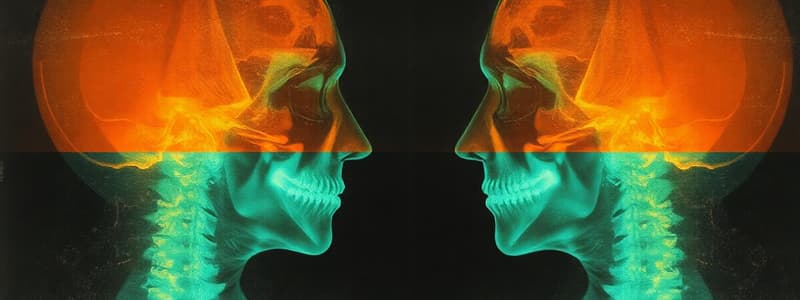Podcast
Questions and Answers
What is a primary reason for the loss of sharpness in radiographic images?
What is a primary reason for the loss of sharpness in radiographic images?
Which of the following factors does NOT control distortion in radiographic images?
Which of the following factors does NOT control distortion in radiographic images?
What information must a radiographer ensure is clearly displayed on a radiograph?
What information must a radiographer ensure is clearly displayed on a radiograph?
What is the minimum number of projections required when examining joints of the body?
What is the minimum number of projections required when examining joints of the body?
Signup and view all the answers
Which of the following is critical to determine the accuracy of body side markers in a radiograph?
Which of the following is critical to determine the accuracy of body side markers in a radiograph?
Signup and view all the answers
Which term describes the position where the patient is lying down and the beam is horizontal?
Which term describes the position where the patient is lying down and the beam is horizontal?
Signup and view all the answers
In radiographic imaging, what does C.R. alignment refer to?
In radiographic imaging, what does C.R. alignment refer to?
Signup and view all the answers
Why is standardization of radiographic projections important?
Why is standardization of radiographic projections important?
Signup and view all the answers
What does the Central Ray (CR) refer to in radiographic procedural technique?
What does the Central Ray (CR) refer to in radiographic procedural technique?
Signup and view all the answers
What is an exception to the principle of right angles in radiographic projections?
What is an exception to the principle of right angles in radiographic projections?
Signup and view all the answers
Study Notes
Radiographic Positions
- Erect and recumbent positions are standard for imaging.
- Decubitus position involves lying down with a horizontal beam; variations include lateral, supine, and prone.
General Radiographic and Imaging Principles
- Two orthogonal projections are necessary to avoid superimposing anatomical structures.
- Essential for localizing lesions or foreign bodies, determining fracture alignments, and confirming pathologies.
Projections for Joint Examination
- At least three projections or positions are needed for joint areas, including an oblique view to assess chip fractures and joint abnormalities.
Standardization of Radiographic Projections
- Standardization maximizes diagnostic information while minimizing radiation exposure.
- Ensures images are diagnostically reliable and comparable to past studies.
Radiographic Procedural Technique
- Key elements include Central Ray (CR) positioning, Source-to-Image Distance (SID) or Focus-to-Film Distance (FFD), patient positioning, exposure factors, collimation, and radiation protection.
Image Quality Factors - Detail
- Loss of image sharpness is primarily due to voluntary and involuntary motion.
Distortion Control Factors
- To reduce distortion, manage Source Image Distance (SID), Object Image Distance (OID), object-film alignment, and CR alignment.
Presentation of Radiographs
- Radiographs are considered legal documents.
- Radiographers must ensure clarity in displayed information, including patient and departmental data, and accurate plate positioning.
Importance of Side Markers
- Proper labeling is crucial to verify body parts and clarify positioning.
- "Side" markers should confirm that the left side is truly represented as such.
Radiographic Examination Requirements
- Consistent positioning principles must include anatomy and standard projection protocols independent of clinical indications.
Modifications in Radiographic Technique
- Techniques may need adjustments based on patient evaluation, body habitus, and specific pathologies.
Evaluation Criteria for Optimal Radiographs
- Key attributes of an optimal radiograph include maximum detail, accurate positioning, adequate penetration, optimal density and contrast, absence of motion artifacts, and the removal of unnecessary artifacts like jewelry.
Studying That Suits You
Use AI to generate personalized quizzes and flashcards to suit your learning preferences.
Description
This quiz delves into the key principles of radiographic projections and positions, such as erect, recumbent, and decubitus. It emphasizes the importance of using orthogonal projections for effective imaging. Perfect for students studying radiography.




